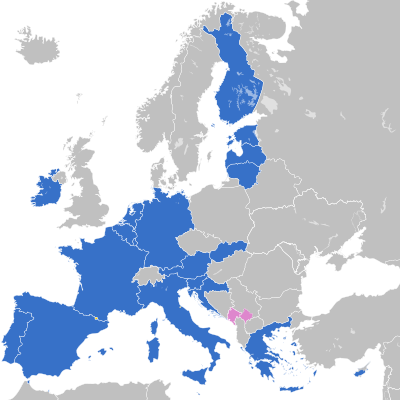Eurozone facts for kids
| Policy of | European Union |
|---|---|
| Type | Monetary union |
| Currency | Euro |
| Established | 1 January 1999 |
| Members | |
| Governance | |
| Monetary authority | Eurosystem |
| Political oversight | Eurogroup |
| Statistics | |
| Area | 2,801,552 km2 (1,081,685 sq mi) |
| Population | 349,256,040 (January 2023) |
| Density | 125/km2 (323.7/sq mi) |
| GDP (nominal) | €13.4 trillion €38,470 (per capita) (2022) |
| Interest rate | 3.50% |
| Inflation | 5.5% (June 2023) |
| Unemployment | 6.5% (April 2023) |
| Trade balance | €310 billion trade surplus |
The euro area, often called the eurozone, is a group of 20 countries in the European Union (EU). These countries all use the euro (€) as their main money. They have fully put in place policies for the EMU. This means they share a single currency and work together on their economies.
The 20 countries that are part of the eurozone are:
- Austria
- Belgium
- Croatia
- Cyprus
- Estonia
- Finland
- France
- Germany
- Greece
- Ireland
- Italy
- Latvia
- Lithuania
- Luxembourg
- Malta
- The Netherlands
- Portugal
- Slovakia
- Slovenia
- Spain
Seven other EU countries do not use the euro. These are Sweden, Denmark, Poland, Czech Republic, Hungary, Romania, and Bulgaria. They still use their own national currencies. However, all of them, except Denmark, are expected to join the eurozone once they meet certain economic rules.
Some countries outside the EU also use the euro. Andorra, Monaco, San Marino, and Vatican City have special agreements with the EU. They use the euro as their official money and can even make their own euro coins. Also, Kosovo and Montenegro use the euro, but they don't have formal agreements. These six countries do not have a say in how the eurozone is run.
Contents
How the Eurozone is Managed
The Eurosystem is like the central bank for the eurozone. It manages the euro currency. The Eurogroup is a group of finance ministers from eurozone countries. They meet to discuss and decide on money matters for the euro area. The European Central Bank (ECB) is very important. It sets the main interest rates for the eurozone. It also prints euro banknotes and makes euro coins.
Since the worldwide financial problems of 2007–2008, the eurozone has created ways to help member countries. If a country faces economic trouble, it can get emergency loans. In return, the country must agree to make economic changes. The eurozone also checks each other's national budgets. This helps countries work together on their money plans. No country has ever left the eurozone, and there are no rules for leaving or being asked to leave.
When Countries Joined the Eurozone
The First Countries to Adopt the Euro
In 1998, eleven countries in the European Union met the rules to join the euro. The euro officially started on 1 January 1999 in these countries. They were Austria, Belgium, Finland, France, Germany, Ireland, Italy, Luxembourg, the Netherlands, Portugal, and Spain. Greece joined a bit later, on 1 January 2001.
These first twelve countries started using physical euro banknotes and coins on 1 January 2002. After a short time, their old national currencies were no longer valid.
New Countries Joining the Eurozone
Between 2007 and 2023, eight more countries joined the eurozone. These were Croatia, Cyprus, Estonia, Latvia, Lithuania, Malta, Slovakia, and Slovenia.
See also
 In Spanish: Eurozona para niños
In Spanish: Eurozona para niños


